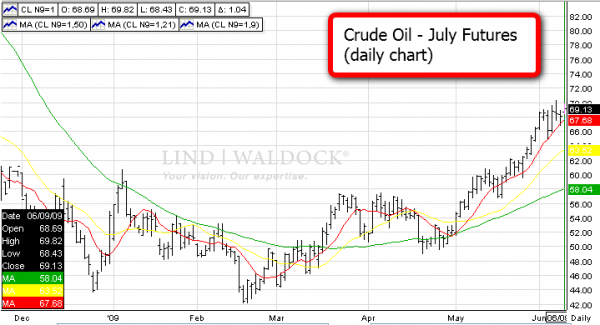Worries about inflation are heating up. Investors have been looking for inflation hedges and turning to commodities. A lot of that interest is directed at the energy markets, sending crude oil to new highs for the year at just above $70 a barrel. This market could be knocking at the door of last year’s record highs if some of the inflation forecasts prove correct. Natural gas has been lagging, but to me, looks like it could be forming a bottom.
Crude Oil
There is no question crude oil is becoming overbought as the market rallied more than 40 percent, or about $20, from its mid-April lows. The weakening U.S. dollar has raised the appeal of commodities in general, and for crude oil in particular as an inflation hedge. As the dollar regained some strength in recent days, traders holding bullish crude oil positions for some time have been inclined to take profits. As July crude oil seems to be facing resistance near $70, some investors are worried they are too late to get in on the trend. I don’t think you’ve missed the move. There will be corrections; use those as opportunities to get in if you are bullish long-term.
It certainly seems as if crude oil prices got ahead of fundamentals. Crude oil stocks are about 61 million barrels above a year ago, and total product demand is down 7.7 percent. Participants have been reluctant to push the market much higher without fresh data to provide incentives.
While I don’t see a major sentiment shift taking place, I think July crude oil futures could correct back to $66 – $65 before making another run to last week’s highs or beyond. A break in this market could come with the Energy Department’s inventory report on Wednesday morning. You have to be patient, and view pullbacks as buying opportunities. I think the 200-day moving average near $65-$66 is a good place to buy. Once this market bounces and moves firmly above $70, who knows where the top might be.
One very long-term inflationary hedge strategy might be to buy December 2016 crude oil $150 calls for about $5,000, not including commissions. Between now and December 2016, I think there’s a good possibility crude could reach $150. What do you think?

Natural Gas
This market has very depressed. In fact, it’s the worst-performing commodity of the year, falling 34 percent and unlike most other commodities, not reacting to the dollar’s weakness. Last week’s jump in the unemployment rate cooled optimism a bit about the economic recovery and undermined sentiment in this market. With storage high, industrial demand weak and temperatures mild, the bearish fundamentals are likely to leave August natural gas in choppy, range-bound conditions for a while longer. The Energy Department has predicted demand for natural gas would fall 8 percent this year. A report by Baker Hughes on June 5 showed rig counts continue to fall, hitting a 6-1/2-year low at 700. I expect this market should remain weak, but summer cooling demand should start to rebalance market fundamentals and push prices higher.
Until fundamentals improve, it may still take some time for natural gas to develop a strong bottom. You could take advantage of the sideways market action with options strategies such as strangles. But when natural gas starts moving, it could turn quickly, so you have to get in at the right time.
From a technical standpoint, an intraday chart shows the channel this market is trading in, but the weekly chart is starting to show a stronger bottoming action taking place. This market is holding below major moving averages. Look for a buy near the bottom of the channel. I would want to see a move past $5 per million Btu before I’m convinced the trend has shifted. If the market can get back above that area, and as the summer starts to heat up, we should see more bullish price action.


There are a lot of ways to trade this market, depending on your account size and risk tolerance. You could consider buying $5 October call options if you think prices will recover. These options cost about $5,800 (your defined risk on the trade) not including commissions.
One thing I would stress if you trade energy markets is that you have to be disciplined. These markets can be volatile. Don’t waste time if you are wrong.
Tim Haberkorn is a Senior Market Strategist with Lind Plus. He can be reached at 800-993-6601 or via email at thaberkorn@lind-waldock.com.
You can hear market commentary from Lind-Waldock market strategists through our weekly Lind Plus Markets on the Move webinars . These interactive, live webinars are free to attend. To sign up, visit https://www.lind-waldock.com/events/calendar.shtml . Lind-Waldock also offers other educational resources to help your learn more about futures trading, including free simulated trading. Visit www.lind-waldock.com.
Past performance is not necessarily indicative of future trading results. Trading advice is based on information taken from trade and statistical services and other sources which Lind-Waldock believes are reliable. We do not guarantee that such information is accurate or complete and it should not be relied upon as such. Trading advice reflects our good faith judgment at a specific time and is subject to change without notice. There is no guarantee that the advice we give will result in profitable trades. All trading decisions will be made by the account holder.
Futures trading involves substantial risk of loss and is not suitable for all investors. 2009 MF Global Ltd. All Rights Reserved. Futures Brokers, Commodity Brokers and Online Futures Trading . 141 West Jackson Boulevard, Suite 1400-A, Chicago, IL 60604.



